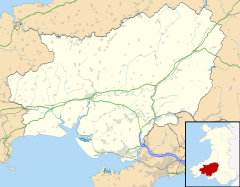Ffairfach is a village one-half mile (0.80 km) south of the market town of Llandeilo in the eastern part of Carmarthenshire, Wales. It is close to the confluence of the Afon Cennen and the River Towy. Population is 516 according to 2017 census.[1]
Etymology edit
The Welsh name for the village is Ffair-fach signifying 'little fair'. In the early 17th century it was recorded as Ffair fach yn Llandilo. The 'large fair' took place in neighbouring Llandeilo.[2] It was reportedly formerly known as Abercennen.
History edit
In the early 19th century Ffairfach was a fair sized village of about three dozen houses. It had a corn mill and a village inn, The Torbay Inn, which doubled as a blacksmiths.[3]
Two fairs were held each year, one on 5 May and a cattle fair on 22 November.[3]
The Union Poor House was built about 1839.[3][4]
The stone used to build the nearby Llandeilo Bridge (1848) was excavated from a quarry near the signal box at the side of the railway and immediately below Rock Villa at Ffairfach, after satisfactory tests for quality.[3]
The British School was established in 1858 near the Torbay Inn. The first schoolmaster was Mr. David Morgan, who later wrote The Story of Carmarthenshire (1908). The council school was built about 1899.[3]
A gas works were erected about 1860.
Railway edit
Ffairfach railway station lies on the Heart of Wales Line which runs between Shrewsbury and Swansea. Ffairfach boasted two railway stations within 300 yards of each other, and a third station at Llandeilo was only a mile or so away. Passengers from the Amman Valley and Carmarthen usually alighted at the Ffairfach stations, as they would save 1+1⁄2 pence on the return fare, which meant a great deal in those days. Also the distance from Llandeilo station to the church square was almost as far as it would be if they walked from Ffairfach.
Three-quarters of the commerce of the town of Llandeilo at this time came from the south of the Tywi bridge; consequently Ffairfach became important, for rail and road passengers made use of the village as the first stopping place en route for Llandeilo.
The first railway through Ffairfach was built by the Llanelli Dock Railway (Llanelli to Llandovery) in 1856. The second was built by the London North Western in 1865 Carmarthen to Llandeilo through the beautiful vale of the Tywi. The name of the station was Llandeilo Bridge.
Education edit
Ysgol Bro Dinefwr edit
Ysgol Gynradd Ffairfach edit
The village primary school was built in 1858. According to the latest Estyn report, there are 106 pupils on roll, including 14 full-time nursery age pupils. The school is categorised as a Welsh-medium school, with 37% of pupils coming from Welsh-speaking homes.[5][6]
Religion edit
Capel Tabernacl in Heol Cennen is an Independent chapel dating from 1860, designed by the architect Thomas Thomas. It replaced a earlier chapels on the site built in 1817 and 1840. The chapel is a Grade II listed building.[7]
Pubs edit
- The Torbay Inn
- The Tregib Arms – an early to mid 19th century building, a Grade II listed building[8]
References edit
- ^ "Wales / Cymru (United Kingdom): Districts & Settlements - Population Statistics, Charts and Map". www.citypopulation.de. Retrieved 31 July 2021.
- ^ Hywel Wyn Owen & Richard Morgan, 2007 Dictionary of the Place-names of Wales, Gomer Press Llandyssul, Ceredigion
- ^ a b c d e Bryn Thomas. "The Good Old Days: Notes and jottings on Llandybie, Llandeilo, Ffairfach and the Amman Valley". Llandeilo.org. Archived from the original on 15 February 2015. Retrieved 10 January 2015.
- ^ "The Workhouse in Llandilo Fawr, Carmarthenshire". www.workhouses.org.uk. Retrieved 31 July 2021.
- ^ "Ysgol Gynradd Ffairfach | Estyn". www.estyn.gov.wales. Retrieved 6 September 2017.
- ^ "Ysgol Gynradd Ffairfach". mylocalschool.wales.gov.uk. Archived from the original on 6 September 2017. Retrieved 6 September 2017.
- ^ "Capel Tabernacl, Cyngor Bro Dyffryn Cennen". British Listed Buildings.
- ^ Cadw. "Tregib Arms (Grade II) (20903)". National Historic Assets of Wales. Retrieved 25 June 2023.
Further reading edit
- Thomas Lloyd, Julian Orbach, Robert Scourfield, Carmarthenshire and Ceredigion - Pevsner Architectural Guides - Volume 6 of The buildings of Wales, Yale University Press, 2006, ISBN 0300101791, ISBN 9780300101799
- Mary Price, Our Story, Fflan, 2011. ISBN 1905979029, ISBN 9781905979028
External links edit
- Ffairfach CP School Archived 14 September 2012 at the Wayback Machine
